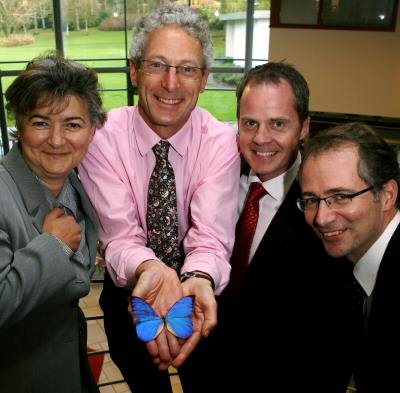 Security technology firm QinetiQ and the University of Exeter in the UK have set up a £3.2m ($5.3m) research project to develop new anti-counterfeit and radio-frequency identification technologies based on structures found on butterfly wings.
Security technology firm QinetiQ and the University of Exeter in the UK have set up a £3.2m ($5.3m) research project to develop new anti-counterfeit and radio-frequency identification technologies based on structures found on butterfly wings.
The three-year project will focus on how the surfaces of butterfly wings control light to produce iridescence, according to the University of Exeter's Dr. Andrew Shaw, who told SecuringPharma.com that the applications could include overt and covert markers for product authentication, as well as ways to improve the reliability of RFID scanning.
"Butterfly wings make use of nanoscale structures to manage light via the interaction of their surfaces with electromagnetic radiation," said Shaw. "Our research centres on making surfaces that use these structures to control electromagnetic radiation at all wavelengths."
Enhanced RFID
The first technology likely to come out of the collaboration - perhaps as early as the first few months of 2010, will be in the area of RFID reading, said Shaw.
Use of RFID to help track-and-trace products through the supply chain is still in its infancy in the pharmaceutical sector, limited to small pilot projects and limited, self-contained implementations which cover only restricted distribution of products.
The reasons for the slow uptake are many, including competing standards and data security issues but also less than perfect reliability in terms of accurate read rates.
"We're looking at materials that will increase the fidelity of the scanning process, by reducing scatter and controlling radiation around the RFID tag reader," said Shaw.
An RFID reader fitted with material to increase the readability is likely to be the first prototype to come out of the collaboration, he added.
Anti-counterfeiting
Meanwhile, the anti-counterfeiting technologies that could arise from the research are remarkable for their versatility. Because they can be interrogated in different ways - exciting the materials using light at a different wavelength or angle can give a different read-out.
At the simplest level, the nanomaterials can be used to create an overt marker on a product or its packaging that gives a distinctive visual signature that can be clearly seen by the patient or healthcare practitioner and is hard to duplicate.
That could be combined with a covert marker which relies on a different form of excitation and so gives a different signature, according to Shaw.
The technology can be used in different ways and at different times to keep one step ahead of the counterfeiters, he added. "A lot of anti-counterfeit features have a certain lifetime before they are copied, but with our structures you can change the way the material is interrogated, and the unique signature produced, every few months."
The £3.2m for the project has been provided by the UK's Engineering and Physical Sciences Research Council (EPSRC), and will be used to manufacture prototypes of the technologies in order to demonstrate them to investors and potential customers. It will provide seed-funding for a company - with shared ownership between the University and QinetiQ - in advance of any venture capital fund-raising.
The team will be hosting a number of investor forum events at the University and in London in the coming months to showcase the technologies, which could also have other applications, including improving wireless networking efficiency.
©
SecuringIndustry.com




 Security technology firm QinetiQ and the University of Exeter in the UK have set up a £3.2m ($5.3m) research project to develop new anti-counterfeit and radio-frequency identification technologies based on structures found on butterfly wings.
Security technology firm QinetiQ and the University of Exeter in the UK have set up a £3.2m ($5.3m) research project to develop new anti-counterfeit and radio-frequency identification technologies based on structures found on butterfly wings.